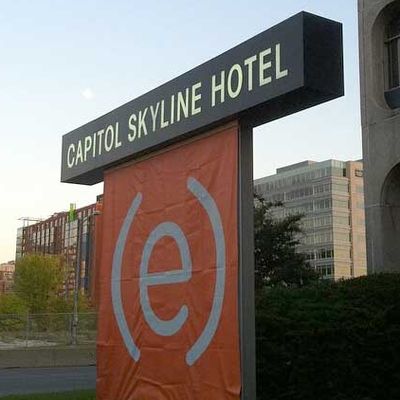
Oh, D.C. art scene! Forever on the verge, constantly gaining steam, yet always and ever  almost.
YouÔÇÖll hear it today, just as you heard it ten, 15, or even 20 years ago: The scene is changing, things are happening. So many of WashingtonÔÇÖs artists, gallery owners, and collectors speak of change, yet it never quite arrives. Even the cityÔÇÖs fledging art fair, which just celebrated its third iteration, is called┬á(e)merge.┬áWhat itÔÇÖs emerging into or out of, or merging onto, has never been quite clear.
The fact is that most┬áambitious D.C. artists still leave for Chicago or New York, and the recent dismemberment of WashingtonÔÇÖs Corcoran Gallery of Art may find more packing their bags. The DistrictÔÇÖs artists relied on that institution for employment that will dry up as the National Gallery of Art and George Washington University assume its payroll. The Corcoran was D.C.ÔÇÖs hometown gallery.┬áSure, it was┬ávilified in 1989, when it cancelled the Robert Mapplethorpe exhibition┬á(solidifying D.C.ÔÇÖs reputation for being culturally and politically cautious), and again in 2005, when it shelved plans for a hyped Frank Gehry addition┬á(solidifying D.C.ÔÇÖs reputation for not taking risks institutionally), yet it remained an anchor for a local art scene even as it was mismanaged into the ground.
The District knows from disappointment, and perhaps the saddest fact is that it hasnÔÇÖt seen a vital scene since the heady 1950s, when Gene Davis, Morris Louis, and Kenneth Noland stained their unprimed canvases here. Members of what became know as the Washington Color School, they were a subset of Abstract Expressionism and creative cousins to Helen Frankenthaler and Mark Rothko. By the mid-1960s, Sam Gilliam, now 81, joined their ranks with his draped works. He remains the most prominent survivor of a group that landed Washington in the art-history books.
Hopes were running high when Mera and Don Rubell bought a seedy Best Western on a scruffy southwest┬áblock in 2002, their┬áintention┬áto transform it, with the┬áaid of Frank Gehry chairs and Saarinen tables, into┬áshabby-chic accommodation.┬áThough their Capitol Skyline Hotel pool thrums in the┬ásummer, the┬áMiami-based power collectors known for transforming young talent into auction-house gold, from Keith Haring to Oscar Murillo,┬áhave so far disappointed the DistrictÔÇÖs artists, though not without trying.┬á(The Rubells are currently in Miami celebrating their 50th anniversary collecting new art with a show called To Have and to Hold at their family museum.)┬áIn 2009, when I was a Washington Post art critic, I followed Mera around a 36-hour whirlwind tour of 36 District artistsÔÇÖ studios, which was like watching Santa visit the land of misfit toys. Last year, Rubell performed the same drive-by tour a 40-minute drive up Interstate 95 in┬áBaltimore, the city home to her latest┬áacquisition and renovation, the Lord┬áBaltimore Hotel, which reopened under the Rubell banner in March.
When I spoke with Mera Rubell last week, she said sheÔÇÖd love to find a Murillo equivalent in Washington. ThereÔÇÖll certainly be plenty of room to display an anointed one alongside the familyÔÇÖs collection in their much-delayed megadevelopment just down the street from┬áthe Capitol Skyline. A historic former school building will be augmented and transformed into 500 apartments, retail space, and a museum ÔÇö the whole complex totaling about 500,000 square feet. A joint venture with a local D.C. developer,┬áthe project is still short construction drawings and permits, but Rubell says they will move ahead soon. No groundbreaking has been announced.
When complete, the campus will include approximately 40,000 square feet of exhibition space, some of which will be reserved for a project-space-cum-incubator for local art. That is, of course, the rub: Setting aside space for D.C. art is affirmative action for the also-rans. ThereÔÇÖs D.C. art, and then thereÔÇÖs the global art world.
For now, the SmithsonianÔÇÖs Hirshhorn Museum and Sculpture Garden remains the cityÔÇÖs flagship venue for contemporary and modern art. Its new director, the 42-year-old Melissa Chiu, is the great hope.┬áChiu left New YorkÔÇÖs Asia Society on the understanding that she could put her fund-raising talents to work for a heartbroken institution that lost its way. She started work September 29, a year and a half since former director Richard Koshalek resigned┬áover the deflation┬áof his so-called Bubble project in May 2013. Designed as a dome-shaped membrane by Diller Scofidio and Renfro, the Seasonal Inflatable Structure (as Smithsonian apparatchiks termed it; the rest of us called it ÔÇ£the BubbleÔÇØ)┬áwould erupt from the center of Gordon BunshaftÔÇÖs concrete doughnut-shaped museum for several┬ámonths each┬áyear and┬áwould┬áhave housed conferences and performances. The scheme won accolades in the architecture community and elsewhere. In point of full disclosure: In 2011 I left journalism and spent two years working on the Hirshhorn payroll as a senior staffer.
But in a metaphor for the general feeling of deflation in D.C. with the arts, it ultimately exceeded the reach of an institution of the HirshhornÔÇÖs modest size, especially an institution subject to additional layers of bureaucracy from ÔÇ£the Castle,ÔÇØ as Smithsonian upper management is known.
Now the HirshhornÔÇÖs future is in ChiuÔÇÖs hands. Though her chilly demeanor stands in marked contrast to her predecessorÔÇÖs almost messianic charm, sheÔÇÖs so far roped in three new board members ÔÇö among them New YorkÔÇôbased Janine Hill, wife of former Hirshhorn board chair J. Tomilson Hill, who quit after one too many disagreements with Koshalek. But it says something all too familiar to Washingtonians that ChiuÔÇÖs first hire, Gianni Jetzer, former head of the Swiss Institute in New York, was recently named curator a large ÔÇö and ÔÇ£at largeÔÇØ means he will remain living in New York.
Now up steps Dani Levinas, longtime Hirshhorn board member and one of D.C.ÔÇÖs few major contemporary art collectors, who, in conjunction with District developer Eastbanc Inc., is trying his hand at institution-building. Levinas plans to make a contemporary art kunsthalle out of a 45,000-square-foot Reconstruction-era schoolhouse that the District of Columbia government has leased to him free for 50 years. LevinasÔÇÖs so-called Institute for Contemporary Expression will include exhibition and performance space, a bookstore, and a restaurant. As of now itÔÇÖs a gorgeous, Adolf ClussÔÇôdesigned structure with peeling paint, exposed wires, and holes in its ceilings that requires $15 million in renovations. ItÔÇÖs unlikely weÔÇÖll see anything ICE-y until well past the best-case 2017 opening projection.
And what of LevinasÔÇÖs links to other D.C. institutions once ICE launches? He said itÔÇÖs unlikely he would remain on the Hirshhorn board much longer, and such is the tale of D.C. arts patronage, which often feels like a zero-sum game. There are only a handful of major collectors, and only so many dollars and so much energy to go around.
So who will drain their bank accounts to launch ICE? Levinas insists that a crop of young collectors is waiting in the wings, but IÔÇÖve yet to see anyone under 40 make a big play in Washington arts. HereÔÇÖs hoping LevinasÔÇÖs wished-for patron demographic isnÔÇÖt just another daydream of the ever-emergent Washington arts scene.


